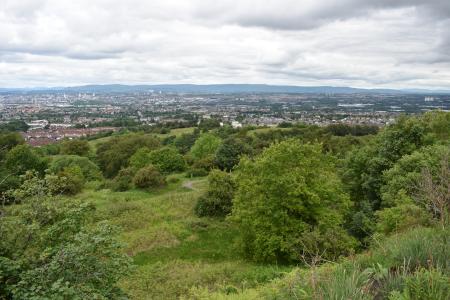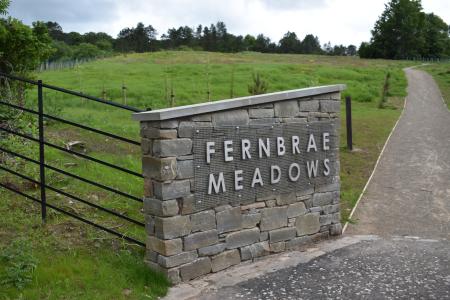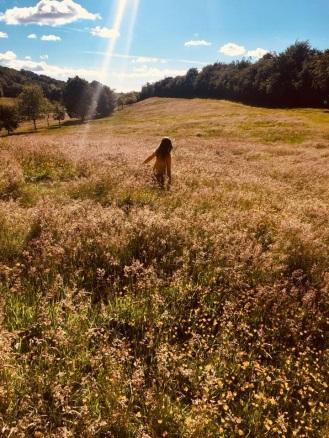
Area characterisation:
The 20 hectare site was a former private golf course, out of use since 2015 and is now operated by South Lanarkshire Council. The Scottish Index of Multiple Deprivation (SIMD) figures for the area surrounding the park are low, with some datazones in the most deprived 5%.
Objective:
The land was in a vacant and derelict state and safety concerns were raised due to vandalisation, fly tipping, vehicle abandonment and fires. The conversion of the site into a new urban park presented an opportunity to address the anti-social behaviour and make the site a desirable area for positive activities and community development. South Lanarkshire Council provided the match funding for the project and applied for funding from the Green Infrastructure Strategic Intervention (GISI), which was granted in 2017. A ‘friends of’ group was established during the implementation period of the project and became involved in community engagement as well as the on-going management and maintenance of the new park. Construction began in 2018 and is due to finish by autumn of 2019.
Key aims:
- Reduce the number of people socially excluded from healthy activity
- Preserve and protect greenspace
- Improve the habitat to restore and encourage greater biodiversity
Images
Financing:
No information
Potential impacts/benefits:
SOCIAL INCLUSION
Events such as Mud Day Mayhem, Dangerous Dad’s Day and the Spring Family Day have encouraged all ages to get involved and spend time in the park, increasing community cohesion and encouraging people to spend time in nature. The Friends of Fernbrae Meadows group have supported the development of the park and they are key to maintaining a strong community link with the park and supporting the ongoing management and maintenance. This will also provide links with local SIMD communities to encourage healthy activity and to take ownership of the site. The ranger service based in Castlemilk uses Fernbrae to unify the two areas by leading walks/cycle through the park. The project has also engaged with local schools (primary and secondary) to encourage the use of the park as an outdoor classroom. Activities such as pond dipping, archaeology, mini beast safari, basic survival skills and river studies will educate children and young people and foster an appreciation for the environment. Additionally, 3761 metres of new walkways and cycle paths will increase accessibility to all corners of the site, encourage active travel and ensure people of all abilities are able to enjoy the park. Space for allotments will also be created which will provide an opportunity for local residents to grow their own food and develop horticultural skills.
Fernbrae Meadows also improveS local resident’s perceptions of their greenspace and a survey carried out in 2018 gathered important baseline information on this. Key results from the survey are below:
- The top three reasons for visiting are 1) fresh air 2) exercising a dog and 3) enjoying scenery and wildlife
- 40% of visitors spent more than one hour at the park
- Around 80% agreed that the park is an attractive place to exercise, de-stress and feel connected to nature
- 70% agreed or strongly agreed that the people who manage the park care about the local community
| “I have no doubt that this park will contribute to greater health and well-being in the area, more opportunities for learning, improved biodiversity and increased community participation” |
| “Fernbrae Meadows is a beautiful natural area and I am very happy that it is currently being developed for everyone to use, especially better access for disabled” |
CLIMATE CHANGE AND BIODIVERSITY
The project will also benefit the environment by creating 20 acres of local nature reserve, 9140 square metres of woodland and over 10,000 square metres of wildflower meadows. Tree planting will improve the biodiversity of the site, as well as sequestering Carbon and uptake of pollutants (NO2, O3, PM2.5, SO2). Trees also have the ability to reduce surface water run-off and prevent local flooding. Approximately 1400 square metres of wetlands will also be created, contributing to flood risk reduction and biodiversity. The wildflower meadows are planted with native species, which will enhance the biodiversity of the park and attract new species.
Actions:
No information
Organisations:
Scottish Natural Heritage
Client:
South Lanarkshire Council
Contacts:
fiona.strachan@nature.scot
NBS goals:
- Urban regeneration through nature-based solutions
- Nature-based solutions for improving well-being in urban areas
- Increasing carbon sequestration through nature-based solutions
NBS benefits:
- Reduce flood risk
- Reduce run-off
- Reducing temperature at meso or micro scale
- Carbon sequestration and storage
- Greater ecological connectivity across urban regenerated sites
- Improve connectivity and functionality of green and blue infrastructures
- Increase achievements of biodiversity targets
- Increase Biodiversity
- Increase quality and quantity of green and blue infrastructures
- Increased cultural richness and biodiversity
- Changing image of the urban environment
- Creation of green jobs relating to construction & maintenance of NBS
- Improve air quality
- Increase accessibility to green open spaces
- Increase amount of green open spaces for residents
- Increase awareness of NBS solution & their effectiveness and co benefits
- Increase communities’ sense of ownership
- Increase social interaction
- Increase well-being
- Provision of health benefits
- Social inclusion
- Social learning about location & importance of NBS

